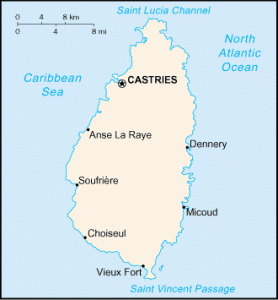St. Lucia
 Saint Lucia’s iconic Pitons – a pair of volcanic spires that vault upward from the Caribbean Sea – define one of the region’s most romantic destinations. Though the trademark vistas that surround the Pitons are perhaps the most memorable, Saint Lucia delivers robust, varied scenery from head to toe. Simply put, the island looks the way the Caribbean is supposed to look.
Saint Lucia’s iconic Pitons – a pair of volcanic spires that vault upward from the Caribbean Sea – define one of the region’s most romantic destinations. Though the trademark vistas that surround the Pitons are perhaps the most memorable, Saint Lucia delivers robust, varied scenery from head to toe. Simply put, the island looks the way the Caribbean is supposed to look.
Castries, the island’s capital, is a busy hub of island commerce and culture. An active cruise-ship port, visitors can invest a few hours at one of two duty-free shopping pavilions along the waterfront. Artists showcase paintings and sculptures in several galleries. Just a few steps from the harbor is the market, where vendors have gathered for more than 100 years to sell a bounty of fresh produce alongside fishermen hawking king mackerel, mahi-mahi and wahoo.
Most of Saint Lucia’s resorts are found north of the capital along the west coast where there are several white sand beaches, notably Rodney Bay. With accommodations ranging from massive all-inclusive to luxury resorts to family-run inns, there’s something for almost any taste or budget. Nearby Rodney Bay Marina serves as home base for many of the charter yachts heading south to the Grenadines. While the white sand beaches are found in the north, few come to Saint Lucia without touring the south, where the island’s natural attractions are concentrated. The drive down the west coast to the town of Soufrière at the base of Petit Piton, the shorter and steeper of the twin pinnacles, is one of the most scenic in all the Caribbean.
Saint Lucia’s spectacle continues below sea level, where the underwater landscape often mirrors the mountain slopes above. Much of the coastline is under the protection of the Soufrière Marine Management Area, which prohibits fishing. The result is a submerged fantasy of colorful fish and some of the most pristine coral reefs in the Caribbean.
General Description:
| Language | English |
| Government | Parliamentary democracy |
| Location | The island of St. Lucia is situated between the Atlantic Ocean and the Caribbean Sea, north of Trinidad and Tobago. Part of the Windward Island chain, it lies between the French overseas departments of Martinique and St. Vincent. |
| Climate and Temperature | Average temperature High/Low. Summer 95/75 degrees F. Winter 85/65 degrees F. Humidity ranges from 66-94%. Average rainfall 3 to 5.7mm. Approximate sunrise 0535. Approximate sunset 1829. |
| Driving | Driving is on the left-hand side of the road, and a driver’s license is required. |
| Currency | E.C. Dollar |
| St. Lucia – Capital | Castries |
| Airport: | George F. L. Charles |
| Land Area | 238 sq. miles |
| Population | Approx 156,000 |
| Ministry of tourism | +758 452 4094 |
| Website | www.stlucia.org |

